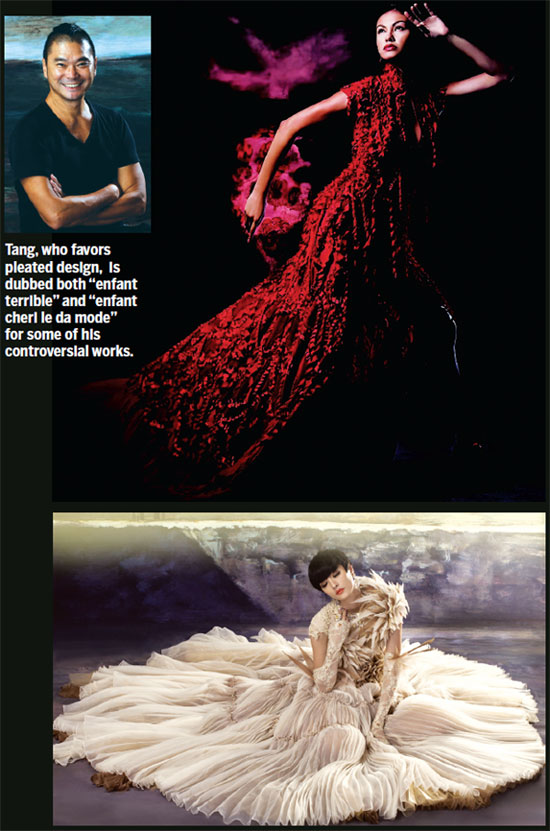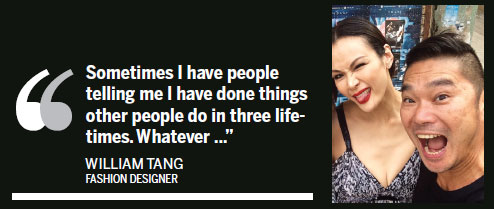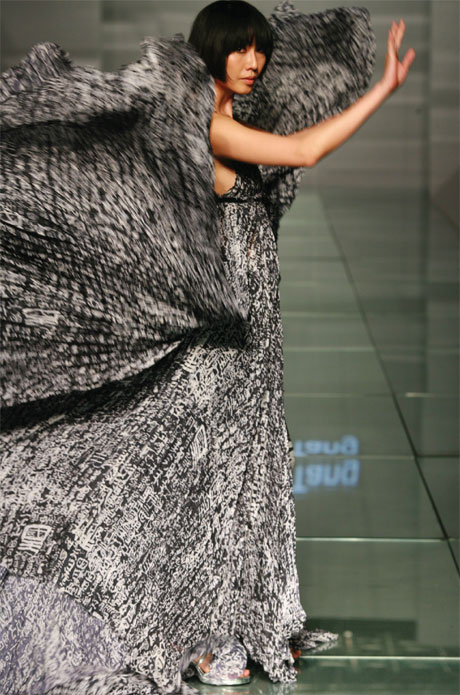A cut above
Updated: 2014-11-24 06:43
By Andrea Deng(HK Edition)
|
|||||||
|
William Tang blends local cultural elements into his signature line - the "King of Kowloon" collection. Provided to China Daily |

Having survived his battle with cancer, William Tang plans to go slow on his vocation and travel more instead. Andrea Deng met the soft-spoken fashion designer who has managed to stay under the spotlight in a 30-year career.
On a Friday afternoon in late October, noted fashion designer William Tang Tat-chi, dressed comfortably in a black v-neck and unadorned black shorts, sat down to talk to China Daily, immediately before moving on to the weekly radio show he has co-hosted for the past 12 years - offering travel tips and personal reflections.
It was hardly surprising that the renowned fashion designer was looking a little tired. He's just been through one of the toughest battles of his life, seven months under treatment for stage-two colon cancer. He underwent surgery in April, and was recuperating with the help of traditional Chinese medicine.
"I didn't freak out, I thought, if I was going to die, so be it, face it," he said.
In 1996, when Tang arrived at the legendary artist's colony of Kunsthaus Tacheles, in East Berlin, he was seized with anxiety about the role he had accepted as fashion designer for a Hong Kong arts show. He felt overwhelmed and amazed by the sheer glamor of the place which had already produced so many artists of renown in just a few years.
Tang remembers standing and examining the stage, which still bore the scar from exploding artillery shells in the closing days of World War II. It used to be a Jewish department store and served briefly as a pre-war Nazi prison. When the building was taken over by underground artists in 1990, during the tumultuous weeks after the Berlin Wall was brought down by a popular uprising - not all were pleased. A scorched wall served as a reminder of the day someone tried to burn down the place renamed Kunsthaus Tacheles (straight talking art house).
Tang wasn't at all confident. He had a small budget. He'd brought only a few young models who just didn't seem "soulful enough" in the context of the place.
He recalled how he turned to his close friend, the influential Hong Kong choreographer, Mui Cheuk-yin, who was also performing at the center. Mui agreed to have her dancers wear Tang's collection of elastic, clingy, black dresses during their improvised dance performances.
Mui commented later that the dresses gave her fresh inspiration and she was delighted at how she could coax these into different shapes during the performances. Also, the dancer-models were given no idea of what they were to wear until the last minute before they went on stage.
Tang's own Hong Kong street scenes became the backdrop for the show - photographs he took when he lived in San Po Kong. By chance, many of the photos had captured much of the idiosyncratic calligraphy inscribed on walls and lampposts by Tsang Tsou-choi - now known locally as the "King of Kowloon". The serendipitous appearances of the calligraphy in Tang's shots would, subsequently, inspire his "King of Kowloon" collection.
That night in East Berlin Tang got a 10-minute standing ovation. The show received wide recognition in local media.
Shock value
Having lost his mother two years ago, Tang is somewhat less worried than he used to be. She had seen two of her daughters die of cancer. While she was alive, Tang's fervent wish was to protect her from the shock of losing more of her progeny.
Having survived cancer, Tang is now intent on changing his lifestyle. He describes himself as a full-time traveler and part-time designer. He loves drawing - a big reason he chose to become a designer, so he keeps at it. His work helps finance his traveling.
His offhand remarks give some insight into how far he has come, through his long career, highlighted by rather eccentric fashion shows that helped build the careers of some of Hong Kong's best-loved models - including Janet Ma and Qiqi.
In the 1990s, public concern groups were outraged when a collection of his featured "heroin syringes" attached to dresses. Tang defended the show saying it was his intention to "bring real-life situations" under the fashion spotlight. Fashion editors dubbed him both as "enfant cheri de la mode" and "enfant terrible".
"Life can be short or it can be longer. Life is not calculated by time, rather by what you have done in it. I have traveled to so many places and met so many people. Sometimes I have people telling me I have done things other people do in three lifetimes. Whatever ..." he said.
Late last month, Tang had a fashion show in Macao - a retrospective of his collections. During the fittings ahead of the show, a lot of time was taken up cleaning up the pieces, and getting them ready. Tang explained to the audience he had thrown away many of the garments but his mother retrieved them. They stayed creased and rumpled until just before the show. Models for the show spent some time trying to figure out how to put some of the clothes on.
The show in Macao was a sentimental journey for Tang. He recalled how exactly 30 years earlier, he had spent three months in Macao, preparing to show his first collection. He was 26, and just graduated from the London College of Fashion.
"I would sit my room at the Hyatt Regency, where the Sands casino is today, along the seaside. I would look out of the window, stare at the sea during sunset while drinking Portuguese sparkling wine and smoking Indonesian Kretek - even though I didn't know how to inhale. I drew sketches. I drank more after dinner until I would collapse. When I woke up the next morning, I took all the sketches down to the coffee shop and sifted through, deciding which design I was going to create."
"When I prepared for the show this year, looking at my earliest designs with my assistants, we wondered why we had not marketed this or that collection. But then I thought, if I spent time marketing those clothes, I probably would not be able to work on the designs I really like," Tang said.
Dealing with the press
The fashion scene has changed quite dramatically in Hong Kong over the years. Tang is not overwhelmed by what he sees in the local press. There aren't any decent fashion magazines in town, just "too many advertisements", said Tang. "I feel a lot of the fashion editors today in Hong Kong don't have the vision for fashion. They seem to be copycats, following the so-called trends," said Tang.
Back in the 1990s, Tang was accused in the fashion press of copying Japanese designer Issey Miyake's collection of pleated fashions. Pleats are one of Tang's favorite design styles, because "every shape and form of clothes are folded differently and have a life of their own".
"I asked the reporter who had made the allegation to read up fashion history. Pleats go back almost to early human civilization. Mariano Fortuny brought it back to the fashion scene. Fortuny used silk, Miyake used polyester, I chose my own raw materials. The styles are all very different," said Tang.
Still, he was so upset that he quit using pleats in his designs for a couple of years. He hasn't quite forgiven the offending female reporter though.
When she wrote about cosmetics, he said to her, "How come you don't have skin cancer after using so many skin products on your face?"
"I could be very mean," Tang says.
He grew up in Yuen Long and still lives there. He is rather soft-spoken even when he has a chip on his shoulder.
Since the show in Macao, Tang confessed he is content just to hea - Cantonese slang for hanging around, relaxing, not really doing anything. "Because I have no pressure any more, I want to finish what I'm doing at the moment and start all over again," he said.
He plans to shut down his eponymous store - William Tang - in Sheung Wan, to rid himself of the fuss about pricing problems with agents. He has a couple of fashion shows coming up on the Chinese mainland. He also plans to work with two Hong Kong garment companies and design clothes on a theme he revealed vaguely relating to Buddhist philosophy.
"I want to reshuffle my life. I want to do what I really like to do, but in a very relaxed way," he said.
Contact the writer at andrea@chinadailyhk.com

(HK Edition 11/24/2014 page5)
